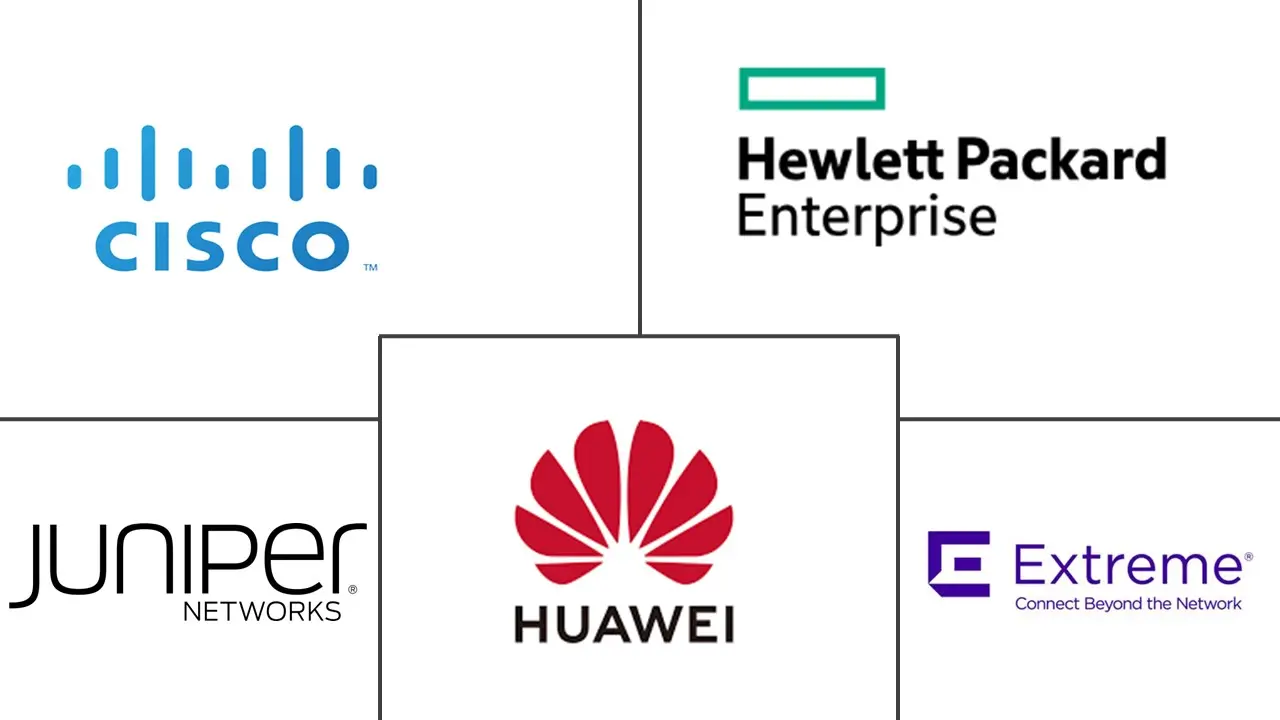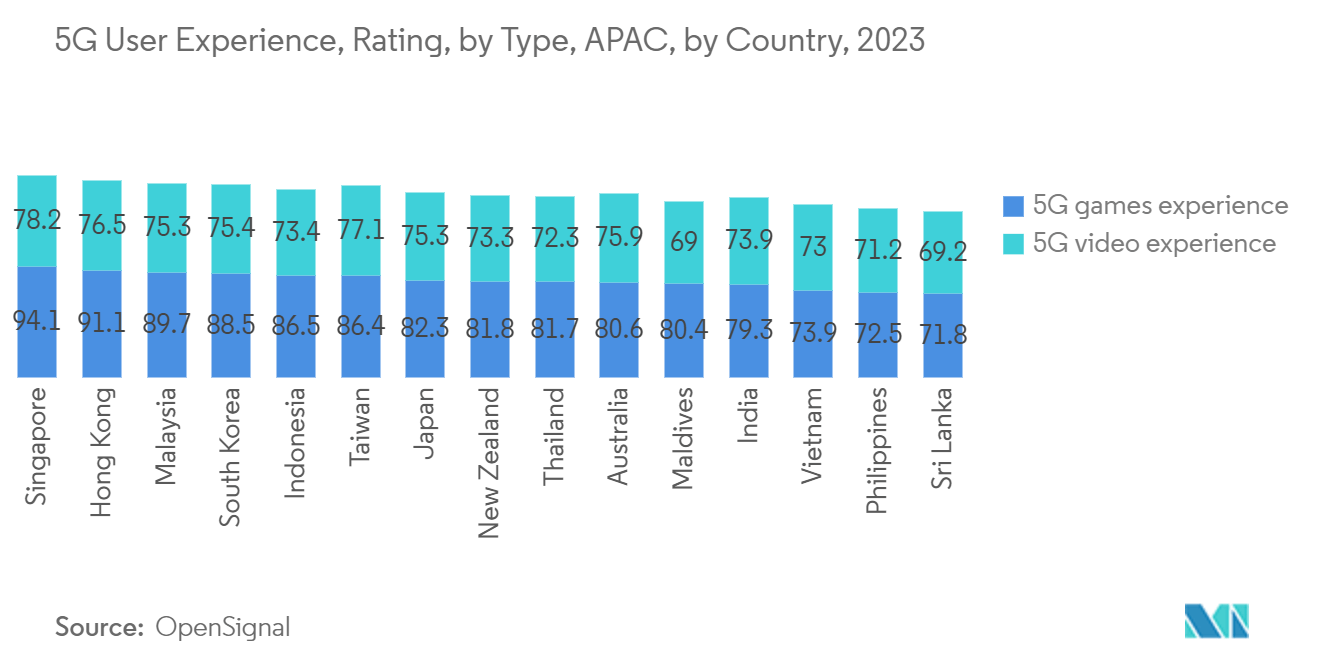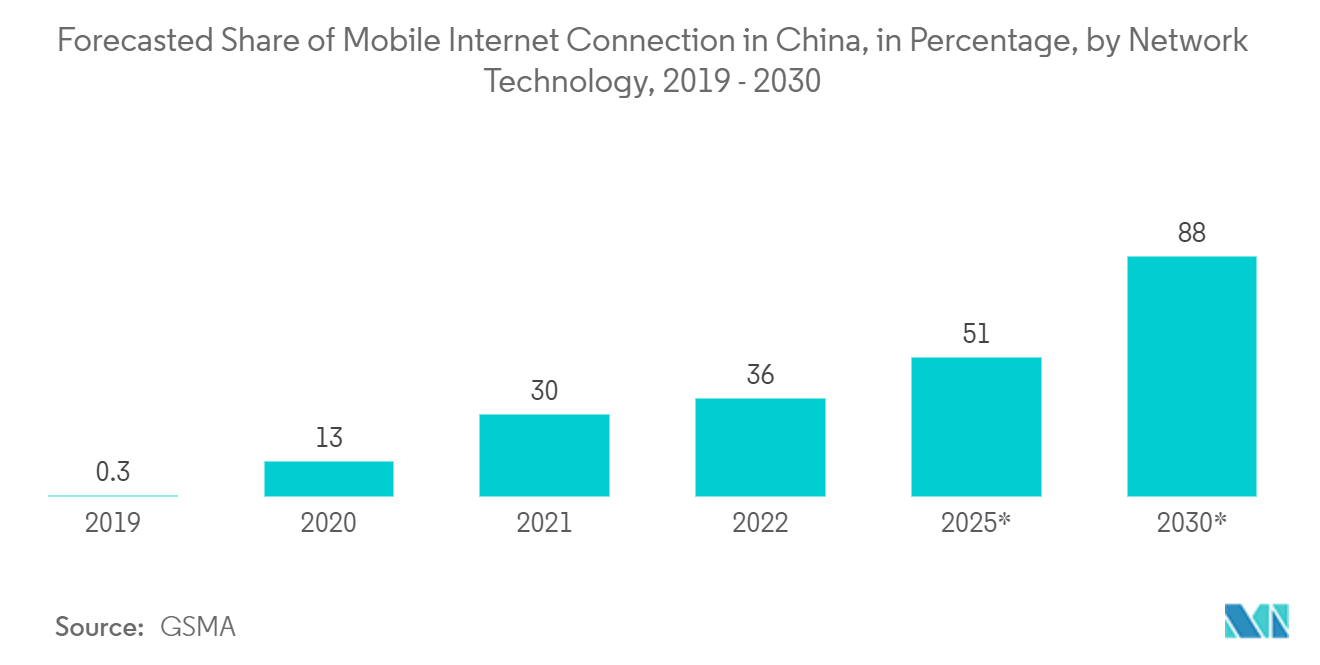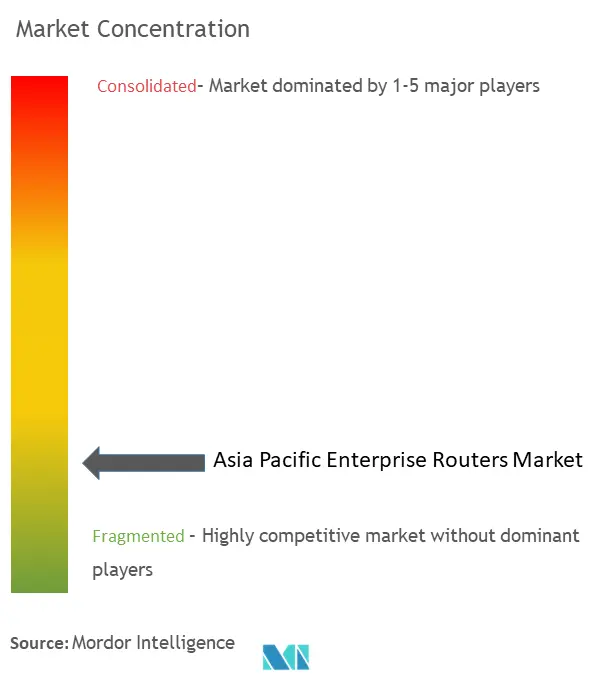Asia-Pacific Enterprise Routers Market Size

| Study Period | 2019 - 2029 |
| Base Year For Estimation | 2023 |
| Forecast Data Period | 2024 - 2029 |
| Historical Data Period | 2019 - 2022 |
| CAGR (2024 - 2029) | > 10.22 % |
| Market Concentration | Low |
Major Players
*Disclaimer: Major Players sorted in no particular order |
Asia-Pacific Enterprise Routers Market Analysis
The Asia-Pacific Enterprise Routers Market is expected to register a CAGR of greater than 10.22% during the forecast period.
- Enterprise routers are becoming increasingly important in delivering safe and dependable remote access to business networks as more employees work online or in distant locations. Routers with VPN abilities and support for reliable remote access protocols enable remote employees to connect seamlessly, allowing them to access company resources and communicate efficiently. According to CNNIC, the number of remote workers in China increased to 540 million in December 2022.
- According to GSMA, by the end of March 2022, 33 mobile carriers had begun offering commercial 5G services throughout 14 markets in the Asia-Pacific, comprising 14 operators across seven nations that also provide 5G fixed wireless access (FWA) solutions. In early adopter regions, including South Korea, where 5G currently makes up around two out of every five mobile network connections, 5G has become widely adopted. The economic recovery following the pandemic, increased 5G smartphone sales, network coverage extensions, and general marketing initiatives have all helped to increase momentum.
- Another significant factor influencing enterprise router sales is digital transformation. New network needs are growing as digital transformation projects gain traction, a development that the COVID-19 pandemic hastened. This puts pressure on IT executives to improve their systems and routers to enhance performance and support various security levels that are becoming more crucial.
- The demand for bandwidth in the Asia-Pacific is increasing significantly due to the rising adoption of bandwidth-intensive applications, cloud services, and IoT devices. Enterprise routers must keep up with this escalating demand to ensure seamless connectivity and optimal network performance. However, older-generation routers may struggle to cope with the bandwidth requirements, resulting in reduced efficiency and slower data transmission. This compels enterprises to upgrade their routers more frequently, adding to the cost and challenging the market's growth.
Asia-Pacific Enterprise Routers Market Trends
IT and Telecommunication to Witness Major Growth
- Asia-Pacific's IT and Telecom industry has witnessed considerable investment in network infrastructure development. Governments, businesses, and service providers have focused on expanding their networks to meet the increasing demand for connectivity. This expansion led to the deployment of larger and more complex networks, requiring enterprise routers to manage and optimize the traffic flow.
- Adopting cloud computing and data centers are the main drivers in the enterprise router market. In Asia-Pacific, cloud service providers and enterprises increasingly leverage cloud infrastructure and host their applications and services in data centers. This trend has led to a surge in data traffic between cloud, data centers, and end-user devices, requiring robust and scalable networking solutions like enterprise routers to manage data flow effectively.
- According to OpenSignal, In 2023, Singapore led the Asia-Pacific region with the highest 5G video user experience rating, scoring 78.2 out of 100. Additionally, the nation achieved the top spot for 5G games user experience, boasting an impressive 94.1 out of 100.
- Edge computing leads to an increased demand for enterprise routers due to the need for reliable, secure, and high-performance networking infrastructure to support the expanding edge deployments and handle the increased data traffic at the network edge.
- The growing investment in telecom infrastructure supports the market growth, as 5G networks require advanced infrastructure to handle high-speed connectivity and increased data traffic. As a result, the market is growing because of the need for 5G-enabled advanced specification enterprise routers.

China is Expected to Hold Significant Market Share
- The infrastructure of China's information technology infrastructure has been expanding significantly, creating a demand for networking equipment such as enterprise routers. Both wired and wireless routers play a crucial role in establishing and maintaining network connectivity for businesses in China.
- Additionally, several public-private partnerships aiming at developing and offering router solutions to underserved and rural areas are anticipated to augment the growth of the regional industry. The "Internet Plus" strategy, which the Chinese government created, has also helped the market develop network equipment, especially broadband.
- The Chinese government is also making significant investments in connectivity and digital infrastructure projects. The need for wireless enterprise routers is projected to expand as more government agencies, departments, and organizations need reliable and secure access to the Internet.
- The State Council's goal for the growth of the digital economy during the 14th Five-Year Goal era in China clearly stated that the digital economy, after agriculture and industry, is the major economic pillar of the entire country. The goal of the country was to have a fully developed digital economy by 2025, with the main sectors of the digital economy's added value estimated to contribute 10% of GDP.
- As per GSMA, the percentage of 5G connections in 2022 was 36%, which is expected to reach around 88% in 2030. Additionally, there were 1.17 billion mobile internet users in 2022, which is expected to rise to 1.33 billion by 2030.
- Mobile networks are already highly densified, but 6 GHz may enable the growth of sustainable 5G capacity on existing sites to allow cost-effective deployments. Also, the timely availability of 6 GHz, at reasonable conditions and price, will drive cost-efficient network deployment, help reduce the broadband usage gap and support digital inclusion. This will augment the market's growth in the country.

Asia-Pacific Enterprise Routers Industry Overview
The intensity of competition in the Asia-Pacific enterprise routers market studied is anticipated to be high and is expected to increase over the forecast period in the market studied. Major factors governing this force are sustainable competitive advantage through innovation, levels of market penetration, barriers to exit, the power of competitive strategy, and the firm concentration ratio. Several large firms dominate the industry, such as Juniper Networks Inc., Cisco Systems Inc., and Hewlett Packard Enterprise. These businesses compete on performance, features, and cost. There are also several small firms that provide Enterprise Routers.
- March 2023 - Huawei and Telkomsel announced that they had signed a Memorandum of Understanding (MOU) on collaboration in joint technologies exploration by embracing "GUIDE to Future Telco." By enhancing their collaboration on digital infrastructure and exploring the possibility of brand-new digital business growth, the two parties will work to offer consumers and enterprises in Indonesia the greatest digital experiences and advanced services.
- February 2023 - Cisco added a 100G service edge to the Catalyst 8500 series. The C8500-20X6C includes feature sets that are highly scalable for the installation of routing and SD-WAN. The most suitable platforms for multi-tenant edge/hubs, colocation-hosted multi-cloud gateways, SD-WAN remote access aggregation, border routers in multi-region fabrics (MRF), IPsec gateways for private 5G-IoT endpoints, multi-cloud services edges, and other functions are available on this one.
Asia-Pacific Enterprise Routers Market Leaders
-
CISCO Systems Inc.
-
Huawei Technologies Co. Ltd
-
Hewlett Packard Enterprise
-
Juniper Networks Inc.
-
Extreme Networks Inc.
*Disclaimer: Major Players sorted in no particular order

Asia-Pacific Enterprise Routers Market News
- April 2023 - Tejas Networks announced that it received an Advance Purchase Order of INR 696 crores (~USD 84.68 million) from BSNL (Bharat Sanchar Nigam Limited) for the upgradation of its pan-India IP-MPLS-based Access and Aggregation Network (MAAN) using its advanced routers.
- January 2023 - Synology announced the launch of the 4-bay Synology DiskStation DS923+, the latest Plus line of all-in-one storage devices for home office and small business users. The DS923+ can be the primary storage and data protection solution or an edge node for multi-site deployments.
Asia-Pacific Enterprise Routers Market Report - Table of Contents
1. INTRODUCTION
1.1 Study Assumptions and Market Definition
1.2 Scope of the Study
2. RESEARCH METHODOLOGY
3. EXECUTIVE SUMMARY
4. MARKET INSIGHTS
4.1 Market Overview
4.2 Industry Attractiveness - Porter's Five Forces Analysis
4.2.1 Bargaining Power of Suppliers
4.2.2 Bargaining Power of Consumers
4.2.3 Threat of New Entrants
4.2.4 Threat of Substitutes
4.2.5 Intensity of Competitive Rivalry
4.3 Impact of COVID-19 on the Market
5. MARKET DYNAMICS
5.1 Market Drivers
5.1.1 Growing Demand for High-speed Connectivity for Faster Data Processing and Transfer
5.1.2 Rising Adoption of Advanced Technology
5.1.3 Rapidly Declining Cost
5.2 Market Restraints
5.2.1 Decreasing Shelf Life Leading to Lower RoI
5.3 Key Use Cases
5.4 Evolution of Technology in Terms of Data Rate and Ports Speed
6. MARKET SEGMENTATION
6.1 By Type of Connectivity
6.1.1 Wired
6.1.2 Wireless
6.2 By Type of Port
6.2.1 Fixed Port
6.2.2 Modular
6.3 By Type
6.3.1 Core Routers
6.3.2 Multi-services Edge
6.3.3 Access Router
6.4 By End-user Vertical
6.4.1 BFSI
6.4.2 IT & Telecom
6.4.3 Healthcare
6.4.4 Retail
6.4.5 Manifacturing
6.4.6 Other End-user Verticals
6.5 By Country
6.5.1 China
6.5.2 India
6.5.3 Vietnam
6.5.4 Thailand
6.5.5 Indonesia
6.5.6 Taiwan
7. COMPETITIVE LANDSCAPE
7.1 Company Profiles*
7.1.1 CISCO Systems Inc.
7.1.2 Huawei Technologies Co. Ltd
7.1.3 Hewlett Packard Enterprise
7.1.4 Juniper Networks Inc.
7.1.5 Extreme Networks Inc.
7.1.6 D-link Corporation
7.1.7 Dell Technologies Inc.
7.1.8 Nokia Corporation
7.1.9 ZTE Corporation
7.1.10 Arista Network
7.2 List of Major Vendors By Country
7.2.1 China
7.2.2 India
7.2.3 Vietnam
7.2.4 Thailand
7.2.5 Indonesia
7.2.6 Taiwan
8. INVESTMENT ANALYSIS
9. FUTURE OF THE MARKET
Asia-Pacific Enterprise Routers Industry Segmentation
An enterprise router connects on-premises and virtual private clouds (VPCs) networks to form a single hub network. It offers high bandwidth, high specifications, and delivers high performance. An enterprise router has several more features than a household router since it is built to handle more advanced networks than a residential router.
The Asia-Pacific enterprise routers market is segmented by type of connectivity (wired, and wireless), by type of port (fixed port, and modular), by type (core routers, multi-services edge, and access router), by end-user vertical (BFSI, IT & Telecom, healthcare, retail, and manufacturing), by country (China, India, Vietnam, Thailand, Indonesia, Taiwan, and Rest of Asia Pacific). The report offers market forecasts and size in value (USD) for all the above segments.
| By Type of Connectivity | |
| Wired | |
| Wireless |
| By Type of Port | |
| Fixed Port | |
| Modular |
| By Type | |
| Core Routers | |
| Multi-services Edge | |
| Access Router |
| By End-user Vertical | |
| BFSI | |
| IT & Telecom | |
| Healthcare | |
| Retail | |
| Manifacturing | |
| Other End-user Verticals |
| By Country | |
| China | |
| India | |
| Vietnam | |
| Thailand | |
| Indonesia | |
| Taiwan |
Asia-Pacific Enterprise Routers Market Research Faqs
What is the current Asia-Pacific Enterprise Routers Market size?
The Asia-Pacific Enterprise Routers Market is projected to register a CAGR of greater than 10.22% during the forecast period (2024-2029)
Who are the key players in Asia-Pacific Enterprise Routers Market?
CISCO Systems Inc., Huawei Technologies Co. Ltd, Hewlett Packard Enterprise, Juniper Networks Inc. and Extreme Networks Inc. are the major companies operating in the Asia-Pacific Enterprise Routers Market.
What years does this Asia-Pacific Enterprise Routers Market cover?
The report covers the Asia-Pacific Enterprise Routers Market historical market size for years: 2019, 2020, 2021, 2022 and 2023. The report also forecasts the Asia-Pacific Enterprise Routers Market size for years: 2024, 2025, 2026, 2027, 2028 and 2029.
Asia-Pacific Enterprise Routers Industry Report
Statistics for the 2024 Asia-Pacific Enterprise Routers market share, size and revenue growth rate, created by Mordor Intelligence™ Industry Reports. Asia-Pacific Enterprise Routers analysis includes a market forecast outlook to for 2024 to 2029 and historical overview. Get a sample of this industry analysis as a free report PDF download.



